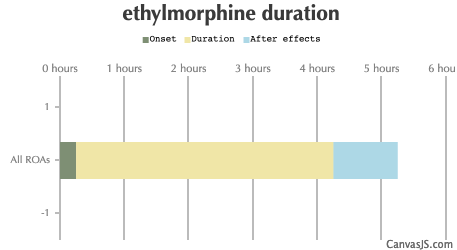[ Home ] [ Controlled Substances ] [ Opioids ]
ETHYLMORPHINE
|
Ethylmorphine is a derivative of morphine with analgesic and antitussive effect. It acts by activating the opioid receptors and thus has a direct influence on the CNS system. Ethylmorphine was approved in Europe for the treatment of dry cough (Codethyline, Dionine).
 Ethylmorphine:
Ethylmorphine:
https://drugs.ncats.io/drug/RWO67D87EU
Ethylmorphine is an opiate narcotic pain killer that can also be found in certain cough medicines. Narcotic refers to a substance that is able to affect behavior, and opiate refers to a drug that is derived from opium. Ethylmorphine is converted to morphine in the liver and as such can be habit-forming in some cases and is typically obtained by prescription only. Cough syrup containing ethylmorphine may be purchased over the counter in certain countries if proper identification is produced. It can also be used during certain ophthalmology procedures dealing with the eyes. Conditions such as miosis can be treated with ethylmorphine. This is when the pupils of the eyes constrict due to certain drugs or other underlying pathological reasons. It is also used as an antitussive for dry, hacking coughs. Antitussive refers to medications that serve to relieve or reduce excessive bouts of coughing. Studies are looking into the possibility of using the drug as a means of reducing withdrawal symptoms for those who are dependent on opioid drugs, which are a class of drugs that act as narcotic analgesics, or pain killers.
Although side effects from taking this medication are few, patients who experience swelling of the throat and tongue, rashes and difficulty breathing should contact their doctor immediately. There can be more serious side effects when the drug is taken in conjunction with alcohol and other medications or street drugs that have an inhibiting effect on the body's central nervous system. People taking certain antidepressant drugs should consult with their doctor as they could lead to severe changes in ethylmorphine's effects. Liver damage is another potential serious side effect of this drug.

https://www.wisegeek.com/what-is-ethylmorphine.htm
Ethylmorphine, is a semi-synthetic morphinan opioid first created by Merck in 1884 and used as a weaker alternative to morphine. Today, it is most commonly used as an antitussive which is available in cough syrup preparations. Ethylmorphine is closely related to morphine and It is also analogous to the other morphinans such as dihydrocodeine, heroin, hydrocodone, and oxycodone.
The active metabolites of ethylmorphine, notably morphine, exert their effects by binding to and activating the u-opioid receptor. This occurs because opioids structurally mimic endogenous endorphins which are naturally found within the body and also work upon the u-opioid receptor set. The way in which opioids structurally mimic these natural endorphins results in their euphoria, pain relief and anxiolytic effects. This is because endorphins are responsible for reducing pain, causing sleepiness, and feelings of pleasure. They can be released in response to pain, strenuous exercise, orgasm, or general excitement.
Ethylmorphine has been described as less potent than morphine but slightly more potent than codeine.

https://psychonautwiki.org/wiki/Ethylmorphine
| Duration: A medium-strength opioid analgesic and analogue of morphine. Considered less potent than morphine but more potent than codeine, and has been used in Germany for this reason. Said to have a 'ceiling' effect where no more euphoria occurs with increased dosage. Under investigation as a maintainance drug in opioid dependence therapy. | |||
| Route | Onset | Duration | After Effects |
|---|---|---|---|
| Tripsit Factsheets | |||

Ethylmorphine Basic Information: http://drugs.tripsit.me/ethylmorphine | |||
| All ROAs: | 15-30 minutes | 4-5 hours | 1-6 hours |

| |||
| Avoid: All CNS depressants. | |||
| Effects: Euphoria, Dry Mouth, Mood lift, Itchiness, Relaxant, Constipation, Pupil constriction, Analgesia. | |||

https://erowid.org/experiences/subs/exp_Pharms_Ethylmorphine.shtml


https://docetp.mpa.se/LMF/Etylmorfin%20Evolan,oral%20solution,%20ENG-PAR_09001be6822cddcb.pdf
Ethylmorphine:
- An opioid analgesic and antitussive
ETHYLMORPHINE PREPARATIONS
|
- Solvipect Comp:
Ethylmorphine combined with guaifenesin - Lepheton:
Ethylmorphine combined with ephedrine - Tussipax:
Ethylmorphine combined with codeine
Cough syrup preparations commonly include a mild laxative to counter the constipation which is a common side effect of opioids.

https://www.erowid.org/experiences/exp.php?ID=62287


https://www.bmj.com/content/bmj/1/3553/local/admin.pdf
Ethylmorphine hydrochloride combination Price - Details concerning the Ethylmorphine hydrochloride combination medication encompass its pricing as well as its availability in various forms, including tablets, capsules, syrups, creams, gels, ... Sunday June 05, 2016 - medindia.net Spasmindon (20mg/11mg) Drug Price and Information - The Price section compares costs of the same generic drugs across brands and is purely for information purpose. Medindia neither buys nor sells drugs. For the above reasons, Medindia cannot be held ...
| ||
| Opioids | Link to this page |




